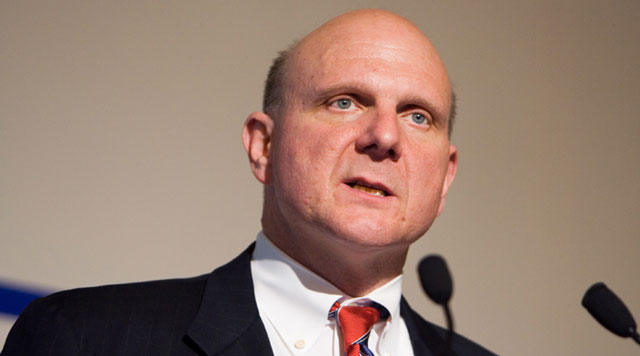
Microsoft CEO Steve Ballmer has a great deal riding on Windows 8. Since he took the helm 13 years ago from his friend Bill Gates, the company’s share price has gone nowhere. The software giant is far from sinking, but it’s slowly taking on water. Windows 8 will be a key product in plugging the hole. But will consumers and businesses warm to it?
Windows 8 has been in development for the past three years, during which time the tablet and mobile-phone markets have grown rapidly and come to be dominated by Apple’s iOS and Google’s Android. The new Microsoft operating system isn’t simply a routine update to Windows 7, but rather a wholesale, top-down revamp that forms part of a broader plan to offer users a cohesive and consistent experience across devices, from desktops and laptops to tablets and handsets.
Windows 8 is all about keeping Apple in check on traditional desktop and notebook PCs, but also — and in conjunction with the new, lighter-weight Windows RT for low-power Arm-based processors — about taking the fight to its rival in the tablet market, where the iPad still dominates.
Forecasts for Windows 8 adoption by analyst firm Gartner show Microsoft will probably have to resign itself to having to play a waiting game. The firm predicts that uptake of Windows 8 on new machines will account for 13,5m of the 432m new PCs shipped this year. It expects the figure to be poorer when it comes to upgrades, with Windows 8 by the end of this year on fewer than 10m of the 1,7bn PCs in use worldwide.
Microsoft needs to hope that it’s done well enough with Windows 8 to make early adopters evangelise about the product.
IDC Middle East & Africa director Mark Walker says that although there will always be loyalists and early adopters, especially among retail consumers, Microsoft’s real battle will be getting business users — its stronghold market — to upgrade to the new operating system, especially if it’s unclear how doing so will be beneficial to them.
Walker says he expects that many companies will put off upgrading to Windows 8 until their next hardware upgrade cycle.
“Microsoft is still the de facto standard in most enterprises,” he says. “The company will promote the migration with enterprises, but I suspect many will resist. I still encounter many companies running [Windows] XP.”
What Microsoft needs to offer companies is a compelling reason to upgrade. It remains to be seen whether a revamped Office suite — Office 2013 is expected to be released in the next few months — will prove to be a sufficient incentive, particularly given that most companies are cutting costs because of the poor state of the global economy.
“IT budgets are still there, and there’s been a growth rate in the high single figures this year, but companies are still polishing every penny,” Walker says. “The question they’re going to be asking is, ‘What does changing my operating system do for me and my business?’ For many, that’s going to be a tough question to answer.”

For Microsoft, patience may be needed. “There’s always going to be the hype around a new release, but that doesn’t necessarily mean swift adoption. Some of the figures I’m seeing are predicting 30% penetration by 2015 and I think that’s probably a fair estimate.”
Walker says that one of the biggest obstacles facing Microsoft with Windows 8 is an older workforce reluctant to make changes unless forced to. “The older the person, the more resistant they are to change and the more likely they are to advance the argument, ‘If it’s working, why change it?’. Newness is not always attractive and there’s a financial implication because the learning curve means you have to train people, which also has direct productivity costs.”
Lower price
Microsoft has, however, reduced one of the obstacles to uptake: the price consumers must pay for the software. At launch, Windows 7 Ultimate cost more than US$300. Windows 8 Pro will cost $40 for a downloadable upgrade or $70 for a physical upgrade copy.
In SA, group buying website Groupon is selling full-version copies of Windows 8 Pro (in other words, not upgrade copies) for R599 including shipping. The website claims the product is valued at R2 000.
Rather than having to choose between multiple editions of the software, Microsoft has moved to a common core upon which users can build and upgrade, Walker says. “There’s going to be a common access point with the ability to buy add-ons as you need them.”
What is crucial is that the add-ons enterprise customers are looking for are available at launch or shortly thereafter. “Availability of Angry Birds is not going to make or break the market,” Walker says. “But you want to make sure the important, big bets are covered.”
He says it appears as if Microsoft has covered its bases when it comes to productivity and enterprise-specific applications, but says the lack of a broader app ecosystem could slow uptake among consumers. Yet consumers are more important than ever because, due to the “bring-your-own-device” culture and the growing number of small businesses, consumers are setting the precedent for enterprise IT spending.
Big bet
Microsoft is a staple of the enterprise market, and there’s no doubt that large companies, which have relied on the software maker’s products for decades, will continue to do so and that many will, with time, move to the new system. The challenge for Steve Ballmer is getting ordinary consumers to care, in the same way they care about new products from Apple.
If uptake is slow, Microsoft’s board could come under pressure from shareholders to make a change at the top. With Windows 8, both Microsoft and its CEO truly are going for broke. — (c) 2012 NewsCentral Media




